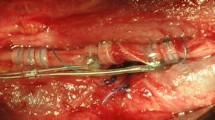Summary
ECG of mole rats (Spalax ehrenbergi) was recorded by chronically implanted electrodes. The average heart rate of unrestrained, resting animals (mean body mass 191 g±35 S.D.) in normoxia and at room temperature is 152 beats/min±42 S.D. It is nonrhythmic and about one third of the rate expected for an animal of this mass. ECG revealed that each heart beat is normal. From atropine and propranolol administration, it was evident that the low heart rate results from : (a) low intrinsic heart rate (285 b/min±30 S.D.), (b) high parasympathetic tone (51%±12 S.D.) and (c) low sympathetic tone (3.6%±1.6 S.D.). Unilateral vagotomy showed that the degree of left or right vagus dominancy in the mole rat differs in each individual: it may even reach a complete left vagus control, in contrast to other mammals where right vagus dominancy is apparent.
Similar content being viewed by others
References
Andersen HT (1967) Cardiovascular adaptations in diving mammals. Am Heart J 74:295–298
Arieli R, Ar A (1981) Heart rate responses of the mole rat (Spalax ehrenbergi) in hypercapnic, hypoxic, and cold conditions. Phys Zool 54:14–21
Arieli R, Ar A, Shkolnik A (1977) Blood-gas properties and function in the fossorial mole rat under normal and hypoxic-hypercapnic atmospheric conditions. Respir Physiol 30:201–278
Bigger JT, Giardina EGV (1974) Rational use of antiarrhythmic drugs alone and in combination. Cardiovasc Clinic 6:103–117
Buchanan JW (1965) Spontaneous arrhythmias and conduction disturbances in domestic animals. Ann NY Acad Sci 127:224–238
Chung EK (1971) Principles of cardiac arrhythmia. Baltimore, Williams and Williams
Darden TR (1972) Respiratory adaptations of a fossorial mammal, the pocket gopher (Thomomys bottae). J Comp Physiol 78:121–137
Detweiler DK, Sporri H (1957) A note on the absence of auricular fibrillation in the European Mole (Talpa europaea). Cardiologia 30:372–375
Gillis RA (1969) Cardiac sympathetic nerve activity: Changes induced by oubain and propranolol. Science 166:508–510
Hamaty D, Truex RC (1954) Effects of vagal stimulation on the distribution of chromatin in the cells of the intracardia ganglia. J Comp Neurol 101:495–514
Higgins CB, Vatner SF, Braunwald E (1973) Parasympathetic control of the heart. Pharmacol Rev 25:119–155
Jones DK, Wang LCH (1976) Metabolic and cardiovascular adaptation in the Western chipmunk, genusEutamias. J Appl Physiol 41:255–270
Koehler RC (1977) The cardiovascular response to hypoxia in conscious dogs. Ph D Thesis, State Univ New York, Buffalo
Lin YC (1974) Autonomic nervous control of cardiovascular response during diving in the rat. Am J Physiol 227:601–605
Lin YC, Horvath SM (1972) Autonomic nervous control of cardiac frequency in the exercise trained rat. J Appl Physiol 33:796–799
Øritsland NA, Stallman RK, Jonkel CJ (1977) Polar Bears: heart activity during rest and exercise. Comp Biochem Physiol 57A:139–141
Schaefer H, Haas HG (1962) Electrocardiography. In: Hamilton WF, Dow P (eds) Hamdbook of physiology, sect 2, Circulation, vol I. Am Physiol Soc, Washington, DC, pp 323–415
Stahl WR (1967) Scaling of respiratory variables in mammals. J Appl Physiol 22:453–460
Tipton CM (1965) Training and bradycardia in rats. Am J Physiol 209:1089–1094
Tipton CM, Taylor B (1965) Influence of atropine on the heart rates of rats. Am J Physiol 208:480–484
Truex RC, Scott JK, Long DM, Symthe MO (1954) Effect of vagus nerves on heart rate of young dogs; an anatomic-physiologic study. J Physiol 22:201–205
Wang LCH, Hudson JW (1971) Temperature regulation in normothermic and hibernating eastern chipmunk,Tamias striatus. Comp Biochem Physiol 38A:59–90
Author information
Authors and Affiliations
Rights and permissions
About this article
Cite this article
Storier, D., Wollberg, Z. & Ar, A. Low and nonrhythmic heart rate of the mole rat (Spalax ehrenbergi): Control by the autonomic nervous system. J Comp Physiol B 142, 533–538 (1981). https://doi.org/10.1007/BF00688986
Accepted:
Issue Date:
DOI: https://doi.org/10.1007/BF00688986




